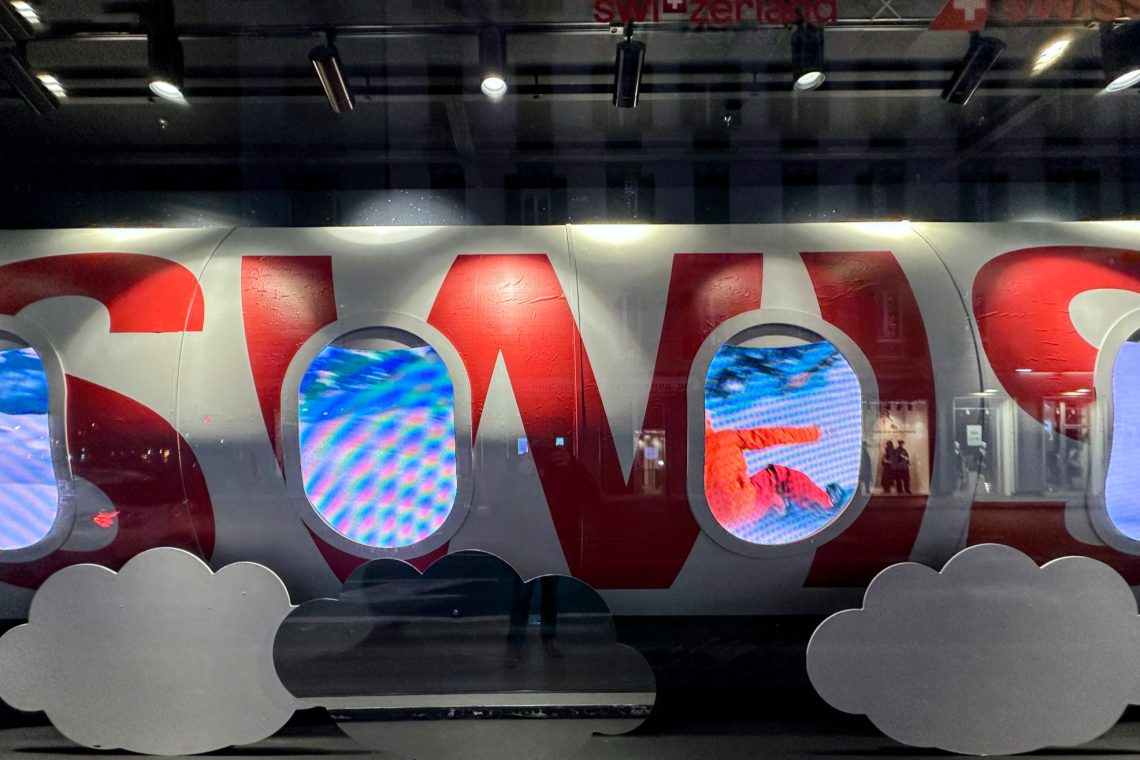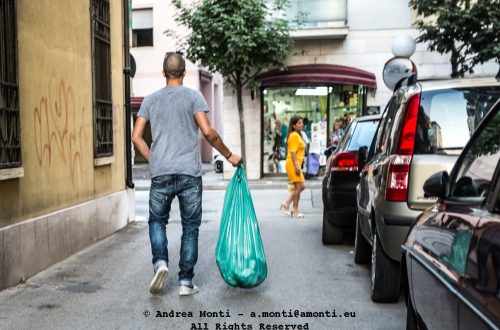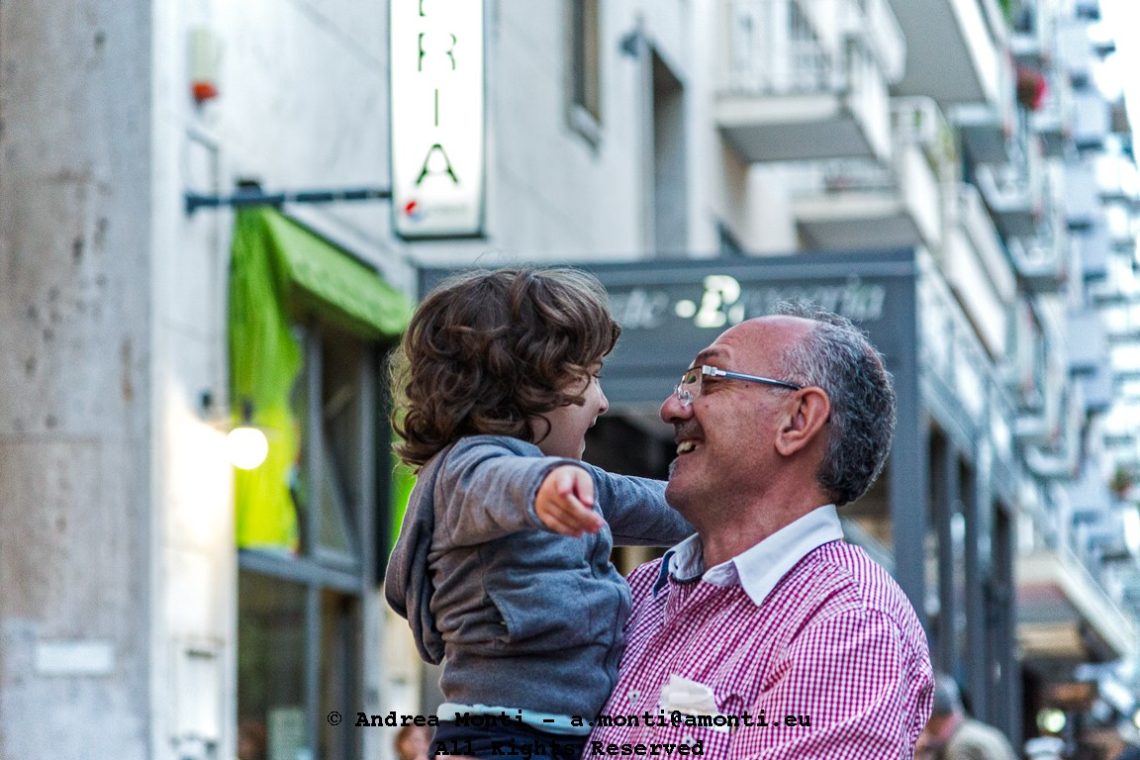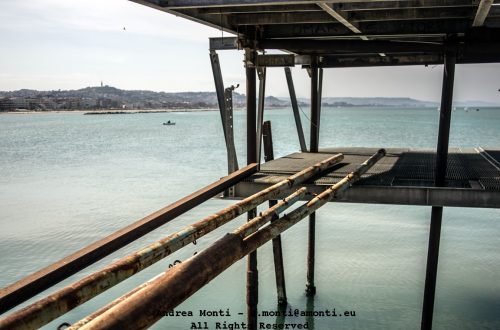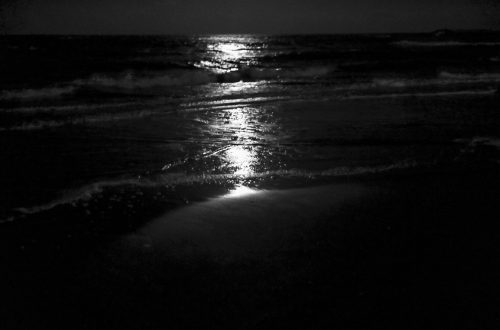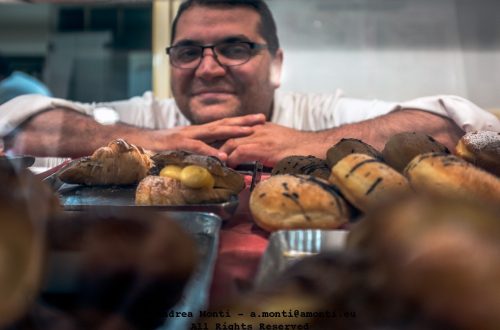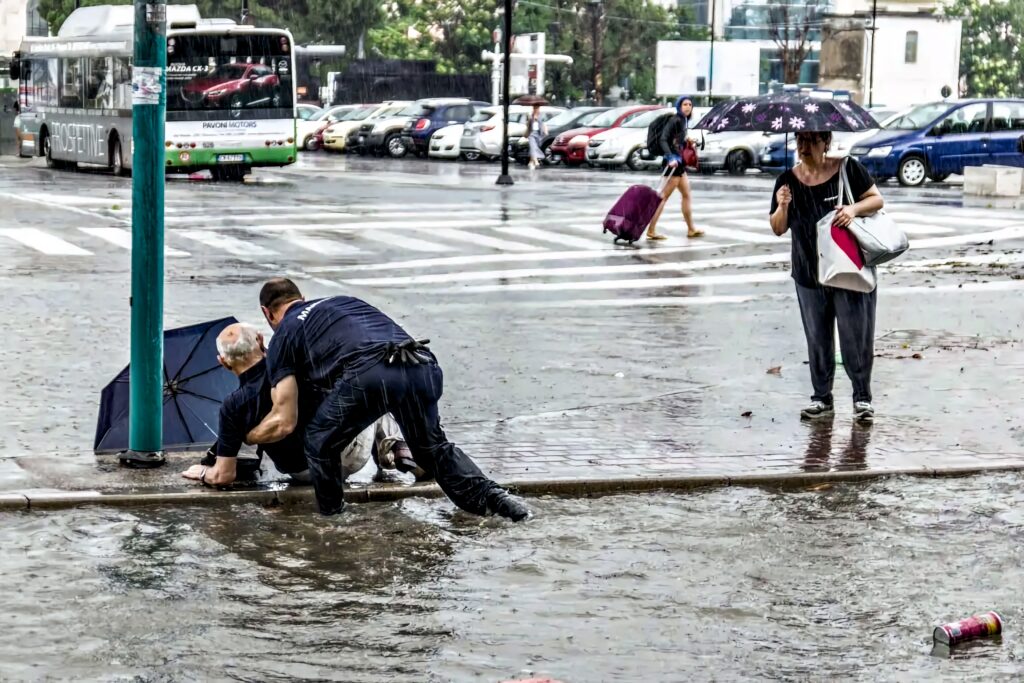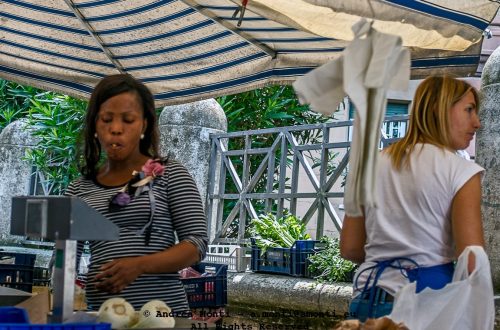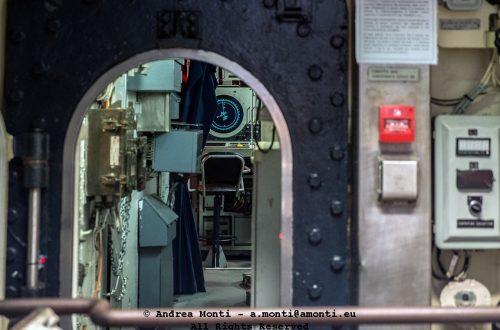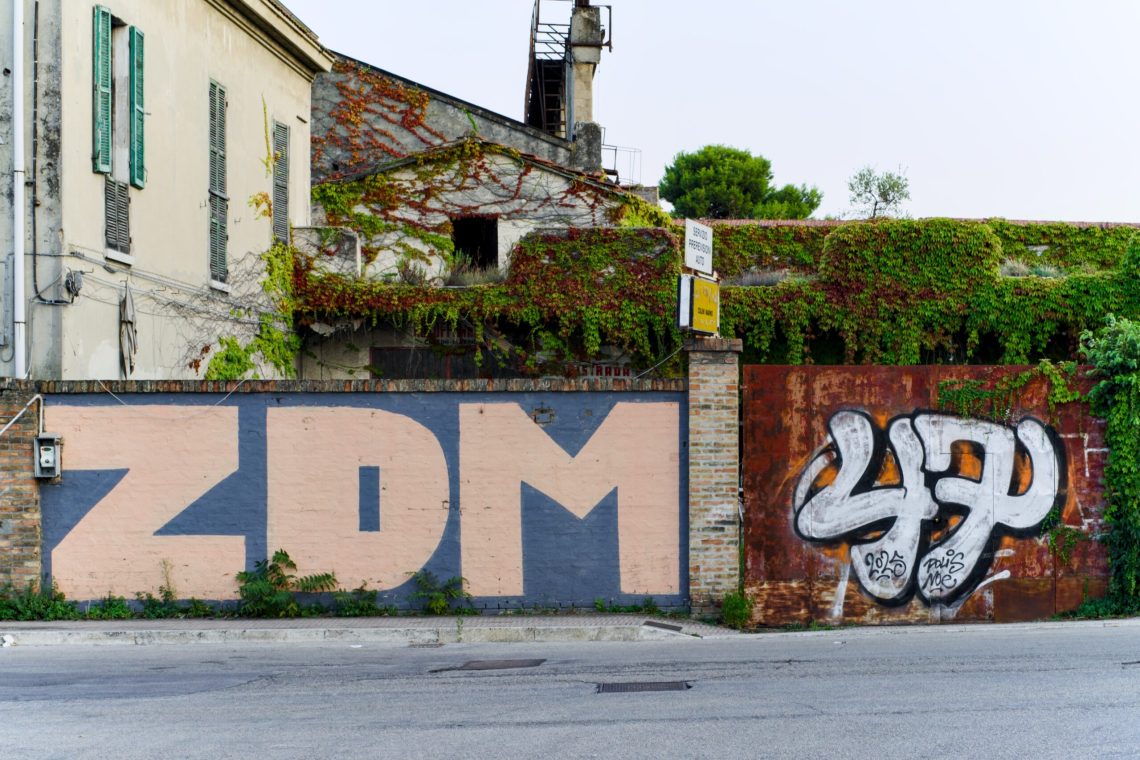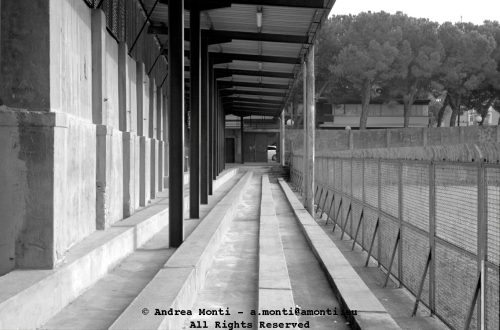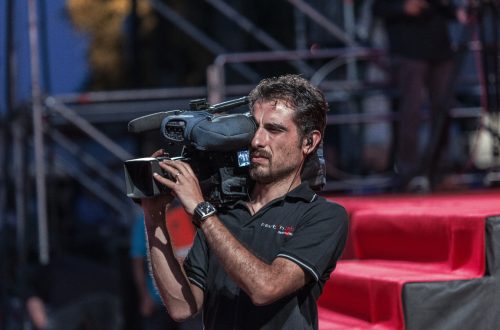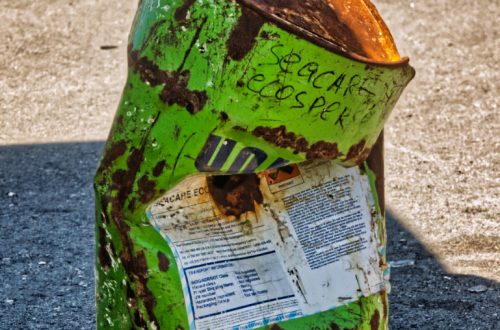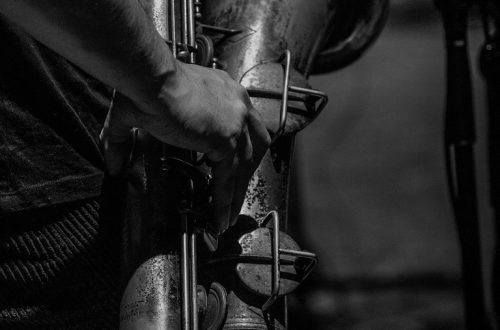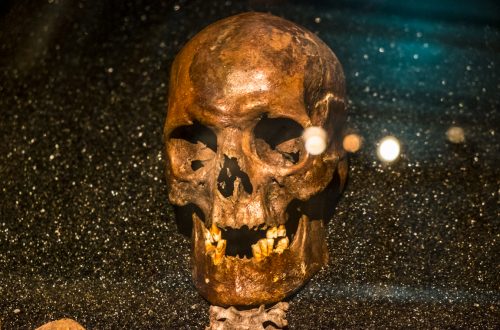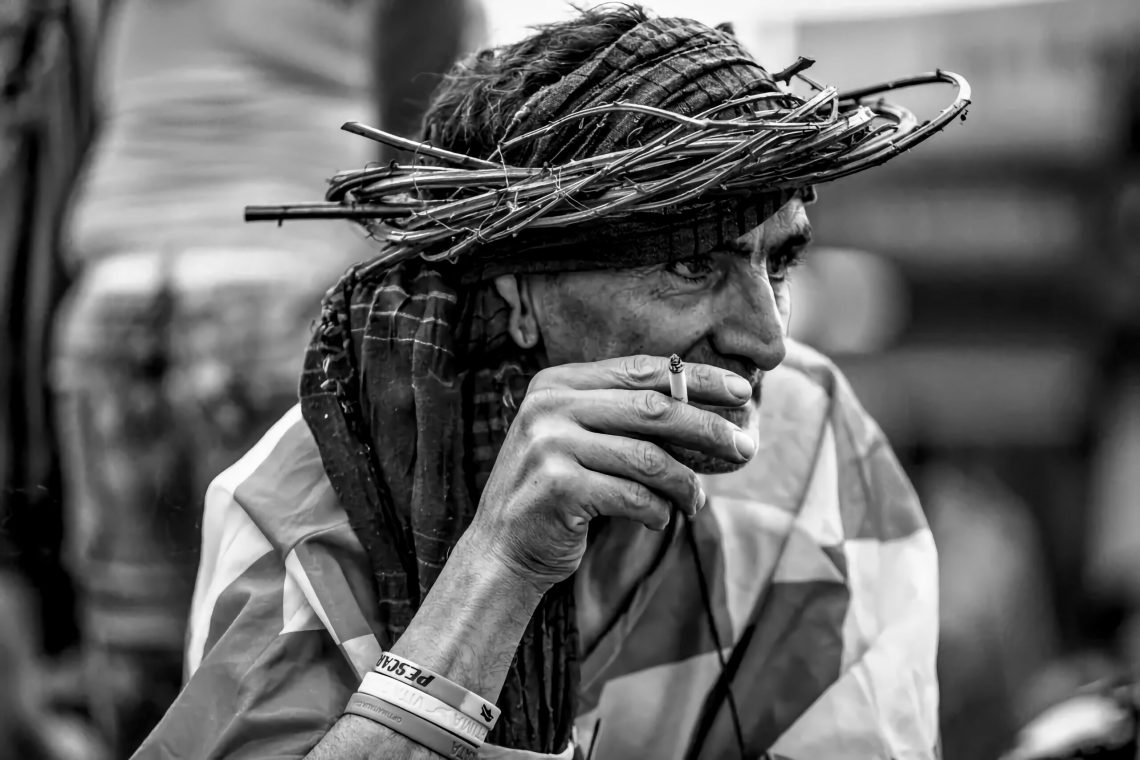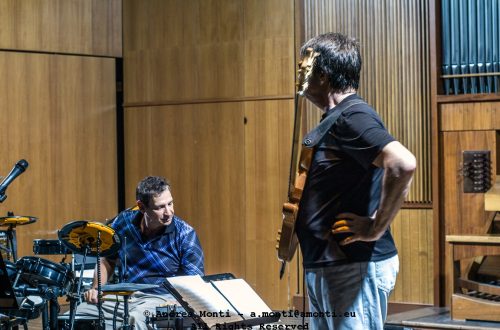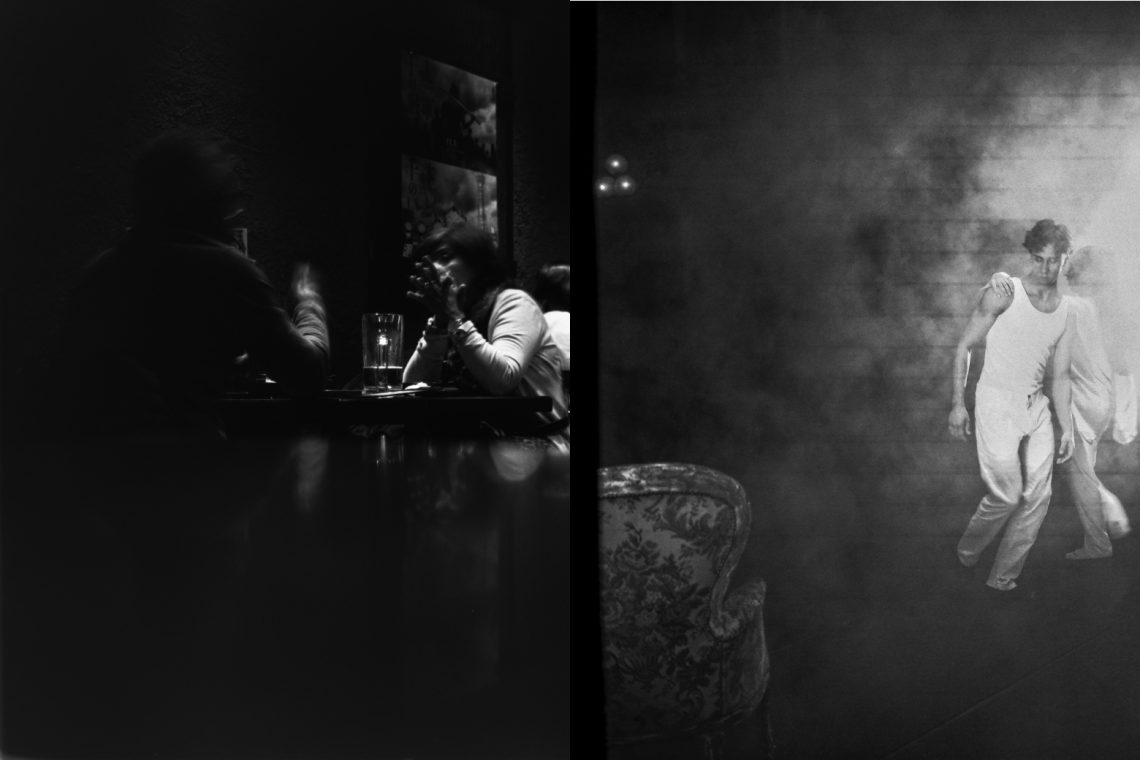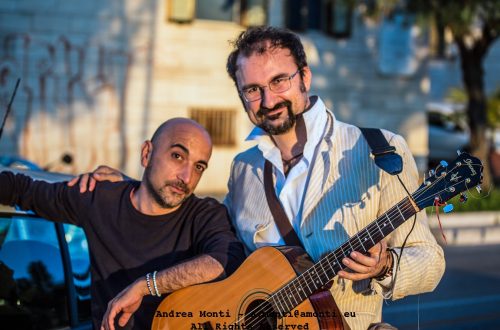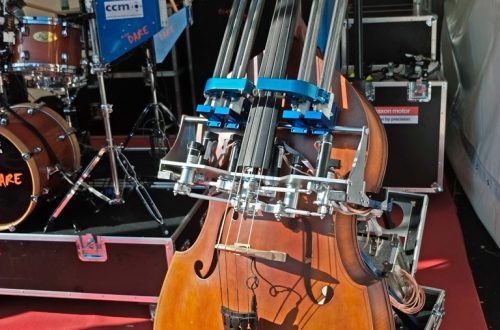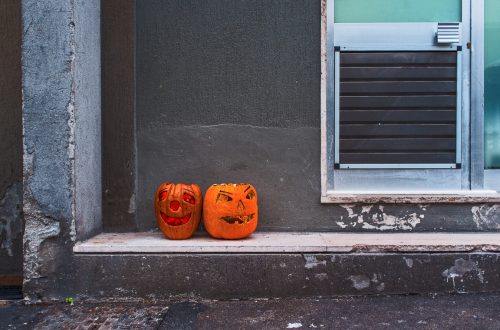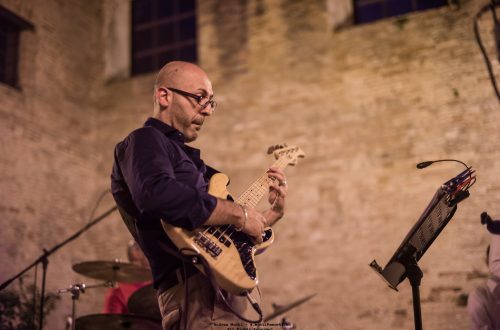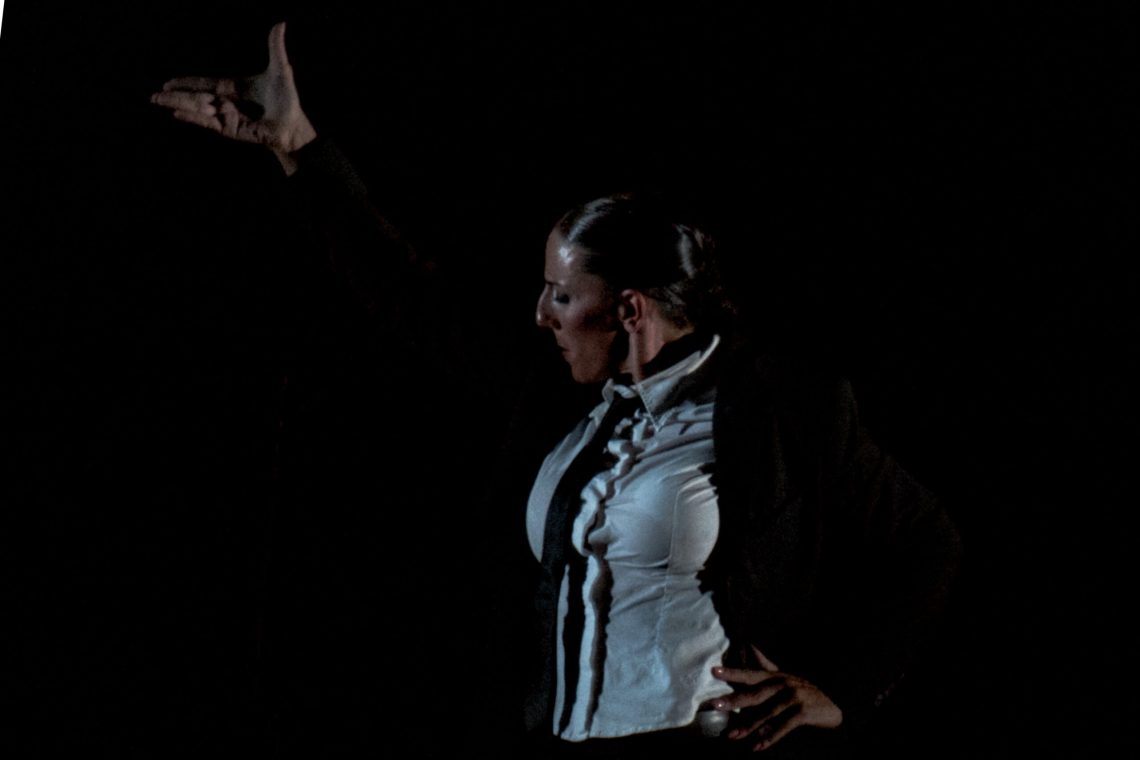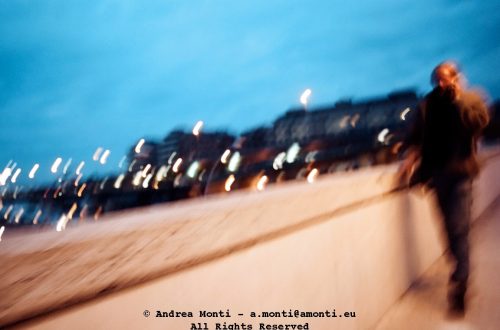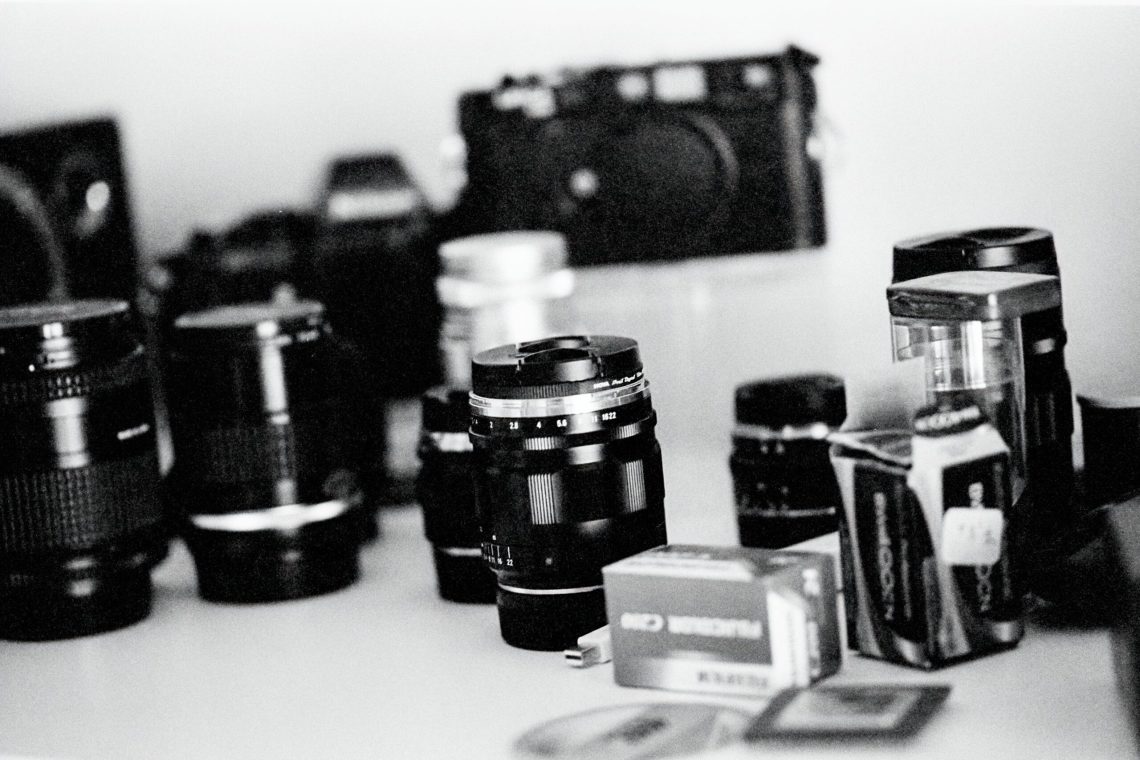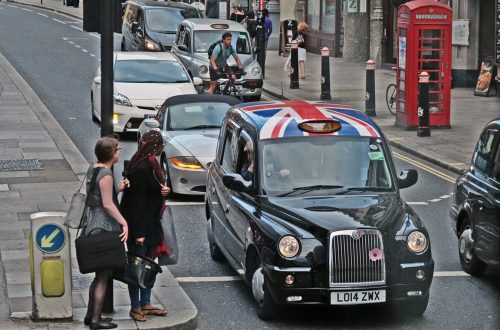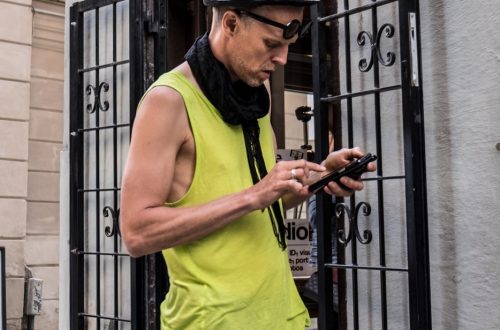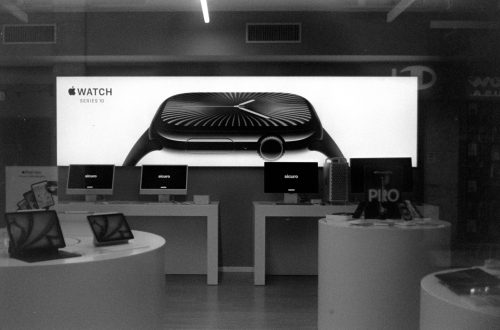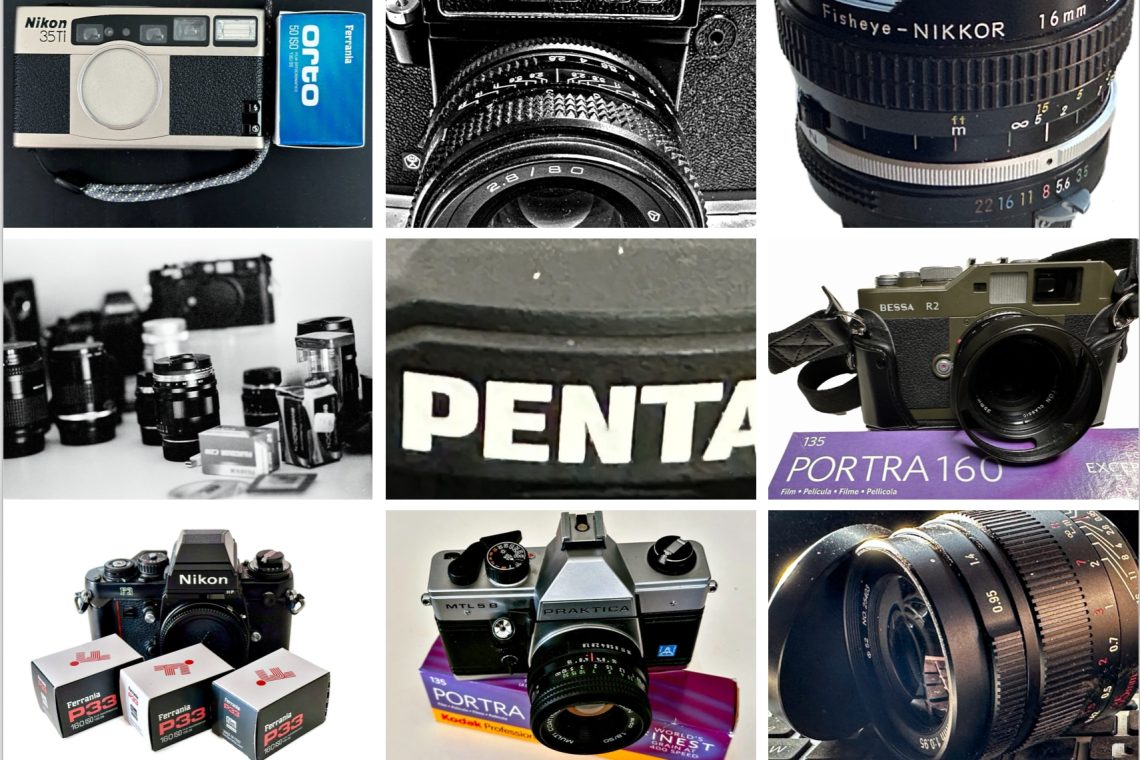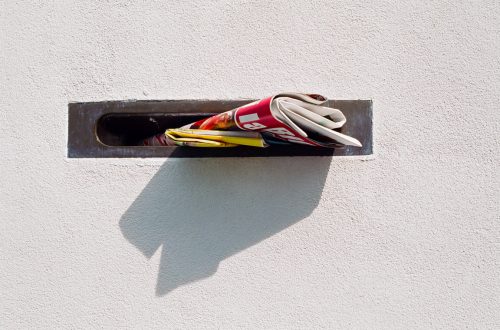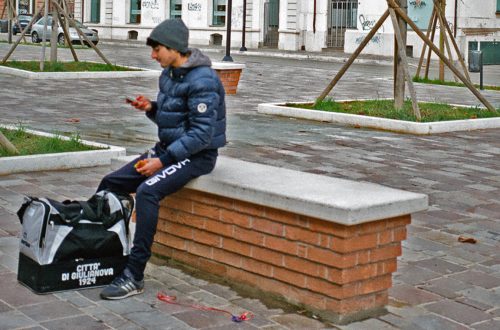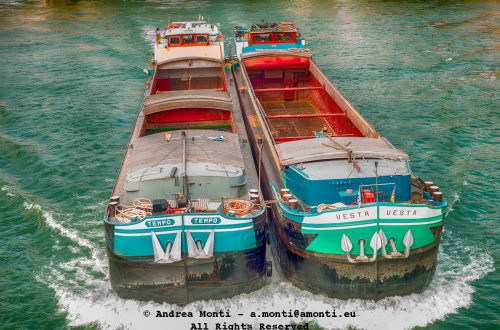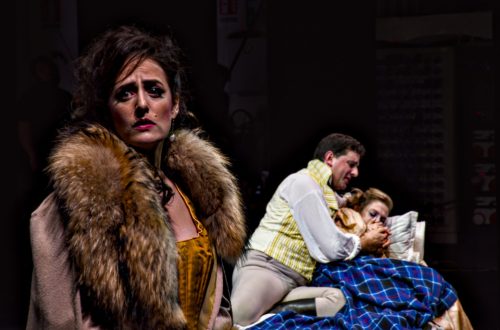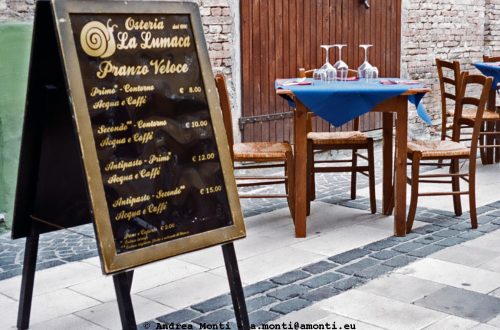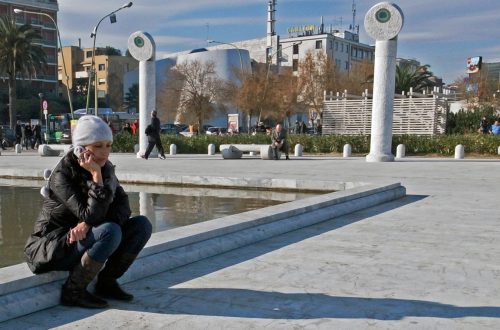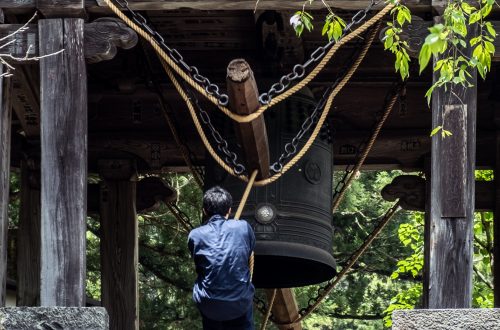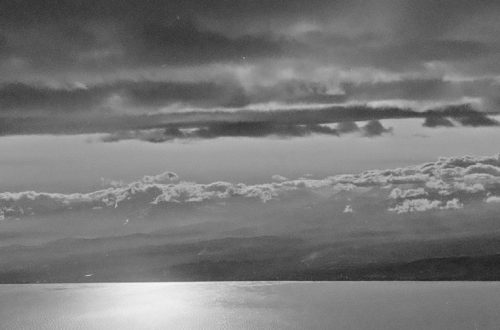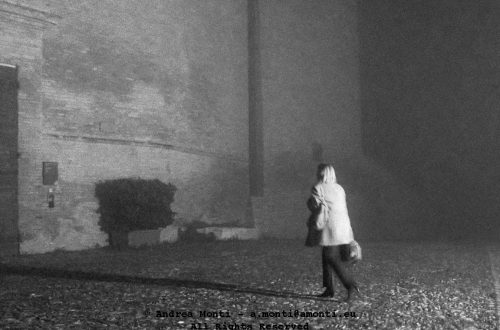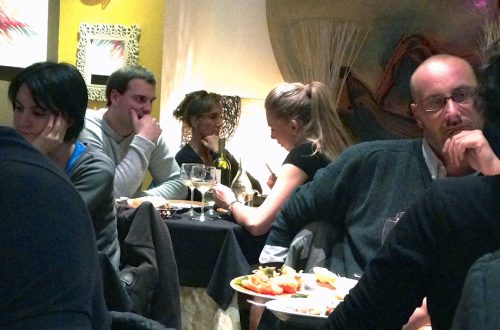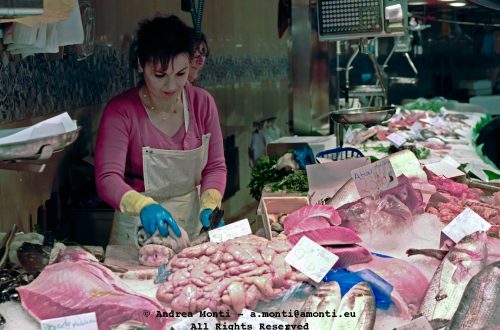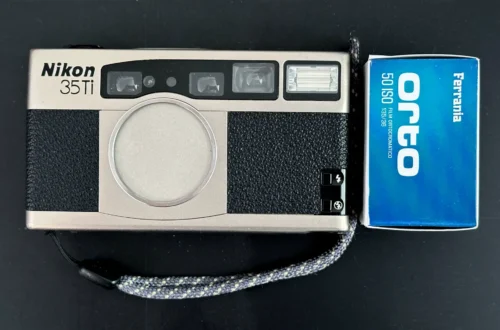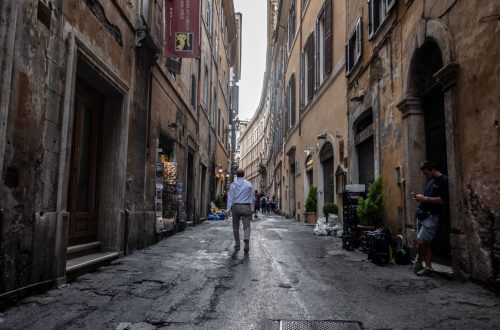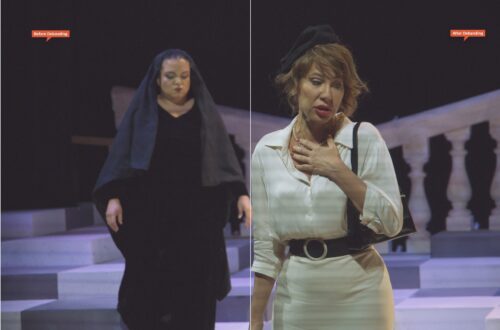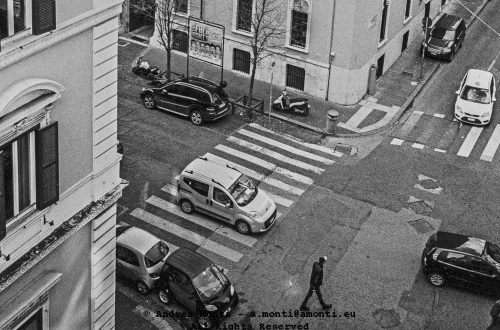-
Cognitive Dissonance
In advertising, sometimes, disregard for reality is a deliberate choice because the aim is to pique the viewer’s curiosity no matter what. At other times, though, it is the result of cognitive dissonance leading to mismatched reality’s depiction, as in the case of the prop in this photo, which I took at La Rinascente in Rome, meant to work as an ad for Swiss International Air Lines and Switzerland as a winter touristic location. At first, I didn’t understand what was wrong with it. The idea looked fairly average —ordinary, I would say: a plane’s fuselage with windows, and videos were shown as if they were the outside view that…
-
What, IMO, Street-Photography Is All About – One Shot Story
I took this picture eleven years ago and, after all this time, it is still a benchmark for my —and I stress the word ‘my’— definition of street-photography. The joy sparkling in the grandfather’s expression and the spontaneous excitement of the kid ignite powerful emotions and remind us of what life should be: happyness and simplicity, instead of sorrows, grief and aggressivity.
-
On Prizes and Awards (a Long and Tiring Musing)
Prizes and awards are ubiquitous also in the photography world. There is an award for everything, and I wouldn’t be suprised to discover an award for the best photo award as well. When we’re just starting out on our photographic journey, it’s natural to think about entering a competition. I am not an exception, in fact I tried a few myself and I also got one honorable mention for the photo featuring this post in a competition organised by a local chapter of the Italian Photoamateur Association (FIAF).
-
Autumn, Colour, Daily photo, PhotoCritics, Photography, Spring, Street Photography, Summer, Technique, Winter
Make Sense (or: Meaning is in the Eye of the Beholder)
I am a big fan of Jim Hall. A god of the Jazz Olympus, he was an amazing guitar player and played (i.e. lived) according to a simple but effective maxim: make musical sense. He jotted it on a scrap of paper and stashed it in his guitar case, so, whenever he took the instrument out, he was reminded to follow the advice. And he did it. This is an excellent advice also in photography and I do my best to follow it, also if I don’t always get it right for a number of reasons, the main one being that meaning is in the eye of the beholder as…
-
Zeiss ZK Planar T* 50mm F/1.4 – Test Shots and an Unpleasant Incident
I am a huge fan of Zeiss lenses, and I have made sure to own at least one of them for each camera system I have used over the years. To be honest, my only regret when switching to Pentax and ditching Leica, Nikon and Canon was that Zeiss lenses in K mount weren’t as widely available as they are for other platforms. Sure, eBay has plenty of them, but I didn’t want to risk the consequences of overseas shipping. Eventually, however, I managed to get a Planar T* 50 mm f/1.4, and last night I went out for the first time to try it with a Pentax K-1.
-
A Few More Shots From An Urban Exploration Trip
Hip-hoppers and skateboarders are often seen together in many urban landscapes. Actually, these performing arts come from different US social and geographical milieus. However, in a world where different paths of life, cultures and traditions matter less and less, and everything is a ‘fusion’, this doesn’t look like an issue. So, while wandering around in search of some subject to test a 50mm Summicron M mounted on a Fuji X-T4, I was fortunate enough to kill two birds with one stone.
-
Personal Musing On Monochrome Digital Cameras
I was thinking of exploring the world of black-and-white digital photography so I started looking into the available options. Currently, only the Leica Monochrom and the Pentax K-3 III Monochrom are still the only native monochrome digital cameras availble, targeting photographers interested in maximising the potential for ‘true’ black-and-white photography compared to converted colour images. Many experts in the field justify the existence of this particular camera by citing the same manufacturers’ marketing claims, such as better overall image quality and the superior performance of a custom-built sensor. However, I am a photographer, not an electronics engineer or software programmer, so I care more about the final results than the technicalities.…
-
On Film Simulation or ‘is fiction more real than reality, and why should we care?’
Simulations have turned an inevitable fact —using the chosen brand and type of film for an entire roll— into an aesthetic tool allowing the selection of the most appropriate image rendition for each single exposure. Using simulations is like having all the different kinds of film in the same roll with all the convenience of digital technology, opening a huge number of creative possibilities. Initially published on 35mmc.com This is what the standard marketing claims for software simulations are based upon, but is that actually so? As a matter of fact, the answer is yes, but if we look at the matter from a different perspective, we should consider some…
-
Some odd outcomes from a photo recovering attempt using an AI
I was curious to see how an AI would handle a bad photo, so I uploaded this black-and-white shot taken in the area around Kyoto Station with my Nikon 35TI. Initially published on 35mmc.com. The photo itself —the one published as featured image— it’s part of a long term project to show the presence of Alfa Romeo (a brand I’m a big fan of) in the Japanese streets. It isn’t anything special, but I needed a starting point (the worse, the better) so, after having uploaded this poor shot, I prompted the software like this: As a professional in photo restoration and post production restore this photograph of an Alfa…
-
On Detachment. Or ‘If You Love Something, Set It Free’ (cit. Sting)
A number of philosophies and religions preach the virtue of detachment from things as a path to enlightenment. When applied to gear, this advice won’t only save your soul —if you believe there’s one— but also your money and, last but not least, your photograph experience. This means avoiding the development of ‘feelings’ towards a camera or a lens that shift from appreciating their value as a tool to some sort of ‘personal engagement’. Initially published on 35mmc.com As odd as it sounds, such an attitude towards an inanimate object is more frequent than one may imagine. A paradigmatic case is the attachment of AIBO’s owners to their robotic pets:…
-
On Tips’n Tricks to ‘take you photos to the next level’
I recently asked a friend, who works on the editorial side of the music industry, to share his thoughts on one of my photographs taken during a flamenco concert. His response was a deep and thorough analysis, which I will spare the readers in full. In brief, however, he praised the lighting as particularly effective for flamenco photography, noting how the chiaroscuro effect recalls the classical paintings of Caravaggio. Regarding the composition, he observed that the bailaora’s body fills the frame dynamically, without ever feeling cramped. In his conclusion, he remarked that the image captures the very soul of flamenco. As flattering as this commentary was, I must admit that none…
-
Why a Longterm Relationship (with your camera) Makes You Feel Good
There is no ‘forever’ in life (life included), and apart from more mundane matters, this is especially true of photography. In fact, the ‘infidelity rate’ that affects many relationships with cameras and lenses is only tamed by the money it takes to break them (and sometimes even the lack of money does not stop them from happening). But at least when it comes to photography, the tranquillity of a stable relationship has some advantages over the excitement of an ever-changing course. From daily and continuous use comes confidence, and from confidence comes a Zen-like state of mind that makes the body to react automatically when the primal part of the…
-
DSLR-like…?
I decided to write this post after having stumbled across the next ethusiast review of a smartphone published on a reputable magazine, claiming that the device can deliver ‘DSLR-like’ photos. In fact, as is often the case with ‘camera experts’ who work for a magazine or earn money by posting videos making funny faces on social networks, it was just a rewrite of the manufacturer’s product specifications and promotional material. There are few things, in photography, I dislike more than than these ‘DSLR-like’ claims made in the advertising of smartphones and compact cameras because ‘DSLR-like’ is the archetype of a meaningless statement made to lure people into using an arbitrary benchmark…
-
To Do or To Own? (or the Photographer’s Dilemma)
To Own or To Do is the photographer’s version of Erich Fromm’s dilemma posed in his famous essay, ‘To Have or to Be’. I don’t have the authority to talk about a complex topic such as the relationship between individual frustration or lack of accomplishment and compensatory or self-delusional behaviour. I would rather like to focus on how putting gear ownership over gear use affects the ability to take meaningful shots. Initially published on 35mmc.com Like many fellow photographers, I have been affected by the Gear Acquisition Syndrome, which in my case has manifested itself not in a quest for a —whatever it means — ‘perfect image’ but rather a…
-
Mir-20 20mm 3.5 on a Pentax K1-II – A Field Test
Photographing with a 20mm lens is quite demanding on the eye, as the composition has to take into account many more objects than with a normal prime or telephoto lens. As a result, it is very easy to get meaningless ‘postcard-like’ images. Not having used such a lens before, I certainly fall into the latter category, so the following photos (possibly, but only one) only serve to show some of the optical features of the lens – Initially published on 35mmc.com Resolution Despite its age (the lens was marketed between 1973 and 1996), the optical resolution is not bad. In this image, apart from the chromatic aberration, you can clearly…
-
7Artisans 35mm 0.95 – Testing this Fujifilm X Mount Lens in a Demanding Environment
So far I have been very happy with the 7Artisans 35mm 0.95 in X-mount, but I have only tested it in non-demanding conditions. Although the results were promising at first sight, only a real test could give a definitive verdict (at least for me). So I decided to put it on trial last December 13, shooting ‘La Cenerentola’, Gioacchino Rossini’s melodrama at the Teatro Marrucino in Chieti (IT), together with the ‘battle-tested’ Fujifilm XF 18-120. Initially published on 35mmc.com Did it work out? Let me spoil the conclusions: I really like this lens in absolute terms and not because of its value for money. The colour reproduction is excellent, the resolving…
-
Colour, Daily photo, Downtown, Nagasaki, Osaka, Photography, Streets&Squares, Thoughts, Tokyo, Travels, Yokohama
Why You Should Only Shoot in Your Backyard (or ‘The Art of Belonging’)
What do these pictures have in common (apart from having been taken in various places in Japan)? No, they don’t have the same look and feel, composition or use of light, nor they convey a particular meaning. What they have in common is that they’re just dull and boring —meaningless, indeed. This picture of the Yokohama’s Chinatown Dragon is hardly different than the others available on the Internet. Initially published on 35mmc.com It shares a similar fate with this one, taken last Mid November in Osaka, and, as Google Lens mercylessly shows, with this one, shot in Omura, near Nagasaki. One can hardly say that this is a never-seen-before view of Tokyo’s Kyu-Shiba-rikyū Gardens, or of…
-
A Few Shots with the 7Artisans 35mm f/0.95 in X-Mount
Let’s get straight to the point: here are a few shots taken with a Fuji X-T4 and a 7 Artisans 35mm f/.0.95 (obviously) in X-mount. All photos were taken at the widest (nominal) aperture of the lens, i.e. 0.95. I’m not sure if this is a real value, but it doesn’t matter because comparing the shutter speed with (relatively) slower lenses like the Zeiss Planar 32mm F1.8 shows that the 7 Artisans is proportionally faster, and that’s enough for me. – Initially published by 35mmc.com This is an 8x crop of the featured image. Even wide open the lens was able to make the Ryanair word easily readable and I…
-
A creative approach to zone focusing with superfast manual lenses and mirrorless cameras in street photography
Manual lenses on mirrorless cameras are often a match made in heaven: (once) cheap, high-quality lenses can finally be brought back from the grave and used on modern cameras. However, as with any marriage, there are some rough edges that are difficult to smooth out. In the case of manual lenses, the main problem is the lack of autofocus, which limits the street photographer’s options. Zone focusing is the usual way to overcome this limitation, but this solution has an inherent problem: to get a decent depth of field, you need to shoot at least at F8 or even F11. This means that, in street-photography, it is not possible to…
-
5 frames with a Canon R6 Mk II and its RF 50/1,2 L USM
I was recently given a Canon R6 Mk II and a set of lenses, including the RF 50/1.2, to test them in a specific environment, so to familiarise myself with the kit I spent a few hours wandering around with the most unlikely configuration for street photography: camera, battery grip and a bulky lens: not exactly what you would call ‘discreet’ or ‘unobtrusive’. However, as counterintuitive as it may seem, I had no problem carrying a ‘real’ camera with all the bells and whistles, as they often seem less threatening and creepy to the casual passer-by, the main target of street photography, because people think you’re just working. There would…
-
Nikkor 16mm Fisheye – Three Ways to Make use of Such a Lens
For me, a fisheye is the most challenging lens to use. Unlike other ‘normal’ focal lengths, a fisheye has an inherent deformation of reality. As a result, it is often used to create images with an unreal rendering, reminiscent of M.C. Escher’s self-portrait looking into a transparent globe.However, as happened in music with the advent of digital processors and effects, it is very easy – at least it was for me – to fall into the trap of focusing on the form rather than the message. In other words, as soon as a ‘weird’ looking photo is achieved, that was enough. Just like playing electric guitar back in the days,…
-
The Ferrania Film Series – Episode 1 – Ferrania Orto shot on October/November 2023
This is the first episode in a series documenting the use of Ferrania film in various contexts. Episode 1 features a Ferrania Orto shot with a Nikon 35 TI in Japan, between 25 October and 1 November 2023.
-
5 frames with a Kiev 60, a Volna 80/2,8 and a Ferrania Orto
Working on a ‘project’ or ‘series’ is a well-known way of giving meaning to the act of taking photographs. It serves many purposes, such as training in a particular technique, familiarising oneself with a camera and/or lens, or exploring stylistic options. A project is usually planned in advance, though not necessarily in great detail. However, as in the case of these images, sometimes the idea of a common thread linking different images just happens. I was wandering around the suburbs of my home town with a Soviet-era Kiev 60 and its ‘kit lens’, the Volna 80/2.8, and a roll of Ferrania Orto when I noticed the oddity of a worn-out…
-
How to Shoot an Handball Match with a Film Camera
Shooting an handball match between Italy and France, unfortunately with an unhappy ending for my Country, was an opportunity to bring back to life the rugged Canon Eos 1V, the mighty fifty and a roll of a (unexpired) Kodak Tri-X 400. When I shoot sports and, in general, events where shutter noise is not an issue, I made a point, indeed, to always carry a film camera, so this time it was Canon’s turn. Shooting handball matches is quite challenging for a number of reasons. The first thing to stick in mind is that the ball is everything: if you miss it, the shot is more often than not a…
